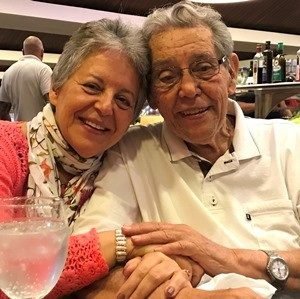Elisaldo Carlini: a view of daughter Célia Carlini
InsCer researcher and professor at PUCRS, Célia Carlini, wrote a personal account full of fond memories for the Brazilian Academy of Sciences about the recently deceased Academymate, her father, Elisaldo Carlini.
“My father was a complex and multifaceted man. Nothing with him was linear. But as the eldest daughter, I feel that I have known aspects of him that others, even my brothers, are unaware of.
It was he who woke up my scientist side. I was 5 years old when he presented me with a taturana, accommodated in a glass jar. He taught me to care for the caterpillar, which could only be fed with a specific type of leaves, which I had to harvest in the garden every day. I saw the caterpillar grow, changing its skin from time to time, and one day, to my great surprise, I didn't find the taturana inside the bottle, but a chrysalis (pupa).
That day, I anxiously waited for my father to return from work to explain to me what had happened to my taturana. He told me that the “mystery” was not yet over, and instructed me to keep the chrysalis in the dark, and to observe it every day.
When the butterfly finally emerged from the chrysalis, I, completely fascinated, had already become a scientist.
During this childhood, I had other experiences with nature with him, which were decisive for developing a complicity that was only ours. Like the ones we live on the coast of São Paulo, on vacation in Praia Grande or Itanhaém, hunting crabs on the beach. To catch these crustaceans, he had a special technique. It had to be at dusk. After a wave, when the sea water returned and before the sand appeared, the crabs formed "mounds" hidden under the flowing water. This was the moment when he placed himself behind the animals, preventing them from returning to the sea, throwing them in the sand, away from the water. I was just smiles, arriving at the beach house after the hunt, with a bucket full of crabs, which after being cooked, were enjoyed by all of us.
Again, also on these beaches, we saw a rare phenomenon, a tide of bioluminescent plankton, which made the waves, when breaking, emit a bluish green light.
Pure magic, which we observe together, with throats choked with emotion.
In 1967, I moved with my mother and brothers to Ribeirão Preto. Even though our daily contact with him had been interrupted, the strong connection we had did not shake. Perhaps it was even reinforced by this forced removal.
He visited us in Ribeirão Preto periodically, but it was the school holidays that I looked forward to when my brothers and I, Beatriz and Álvaro, traveled to São Paulo to spend a few weeks with him. It was at that time, when I was eleven years old, that he started me in the laboratory.
I was going with him to the Santa Casa de Misericórdia in São Paulo, where he was a teacher then. He taught me how to hold rats and mice, and I began to train the animals in various tasks, such as walking through a maze or climbing a rope to get food. After being well trained, the animals were used to assess the effects of delta 9-tetrahydrocannabinol and other active ingredients of Cannabis sativa .
I learned how to inject animals and also helped with several other experiments to evaluate the effects of marijuana, such as Skinner's box, aggression and other social behaviors, motor coordination, etc.
At the age of sixteen, my participation in these experiments gave thanks for technical help in a scientific article by the group. At that time, I no longer questioned my professional vocation. I wanted to be a scientist.
In 1972, I returned to São Paulo to live with my father. From this second phase of daily contact with my father, two permanent marks remained on me, the results of his teachings. He introduced me to lyrical music, opera, requiem, masses and oratories, which we both listened to in ecstasy, until we were moved to tears. As a good descendant of Italians, I learned from him to taste good red wine, the only alcoholic drink that we both really enjoyed.
In 1975, it was time to prepare for the entrance exam, and decide which career I wanted to pursue. Again, my father helped me decide not to do medicine, since what I wanted was to do research (he was a doctor, but he never practiced medicine). I entered the Biological Sciences - Medical Modality course, at the then Escola Paulista de Medicina (EPM).
But it was not easy to be a student at EPM, being the daughter of Carlini, he who had already created and headed the Department of Psychobiology. My grades were excellent, but some of my colleagues looked suspiciously, thinking that the correction of my tests had been "facilitated". And I, however, comparing the correctness of my tests with that of my colleagues, felt the opposite, that more knowledge had been required of me than of others.
It bothered me and I soon decided that, despite being fascinated by psychobiology, I would not conduct my career as a scientist in my father's "shadow". He understood me perfectly, and greatly encouraged me to find out what area of knowledge I wanted to pursue in graduate school, and so, I chose Biochemistry.
My father was a fantastic teacher, enthusiastic, with good oratory, and at the same time he was accessible, and thus captivated the students. In fact, he had the gift of enchanting and fascinating any type of audience, as I have witnessed countless times. I was very happy when my EPM class elected my father as our Patron. It was very exciting when I graduated, in 1978, to have received my diploma from your hands.
In 1980, Jorge and I moved to Niterói, and soon after to Rio de Janeiro, where a new phase of our lives had begun. Living far away, I saw my father less often, when he came to visit us in RJ or when I went to SP. I was a professor at UFRJ, and my career was beginning to assert itself.
I remember an episode, in the mid 80’s, one day receiving a correspondence in response to a request for reprint, which was for him. I celebrated the confusion of the Carlini (s), as this happened for the first time after he received several correspondences that were for me. We played a lot about this episode, he saying that he feared that I would “shadow” his career.
Although we never published together as a guest editor , I invited you to write a review for a special volume of the Toxicon in 2004, and a chapter for the book Plant Toxins (Springer publisher) in 2015, both on the theme of Cannabis and other psychoactive drugs. Over and over again he told me how proud he was of my professional success. It certainly wouldn't have happened like that, without his ever-present incentive and example. ”
Photos: personal archive




